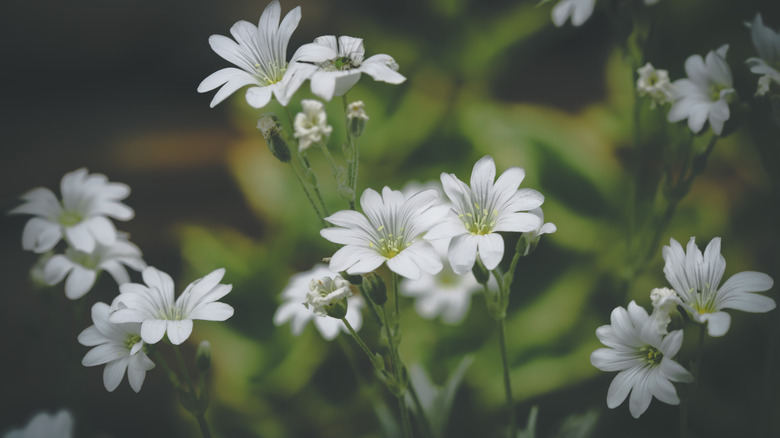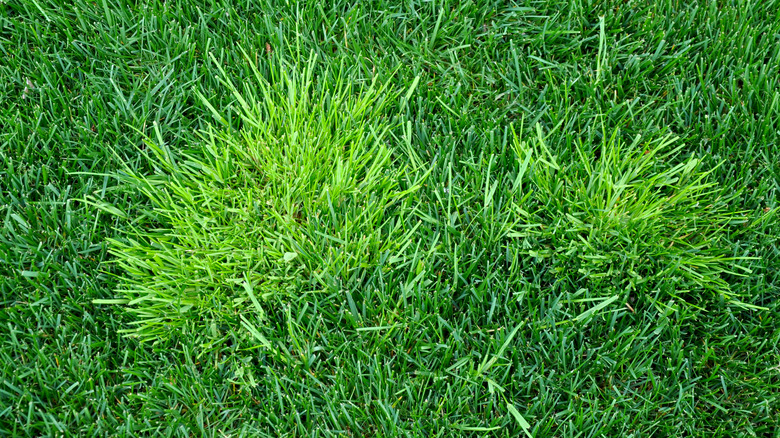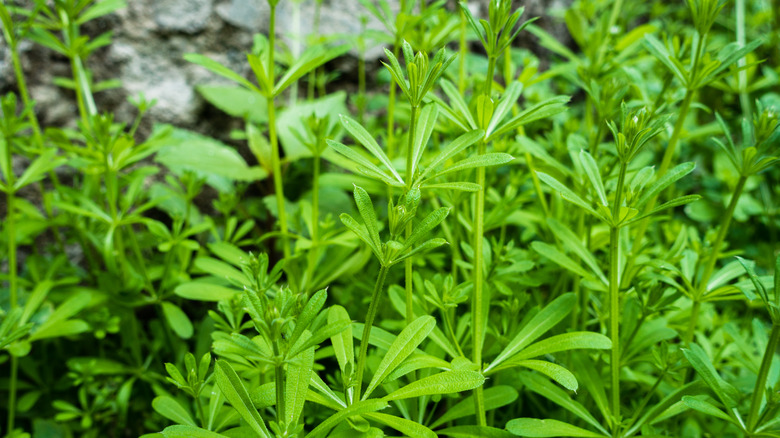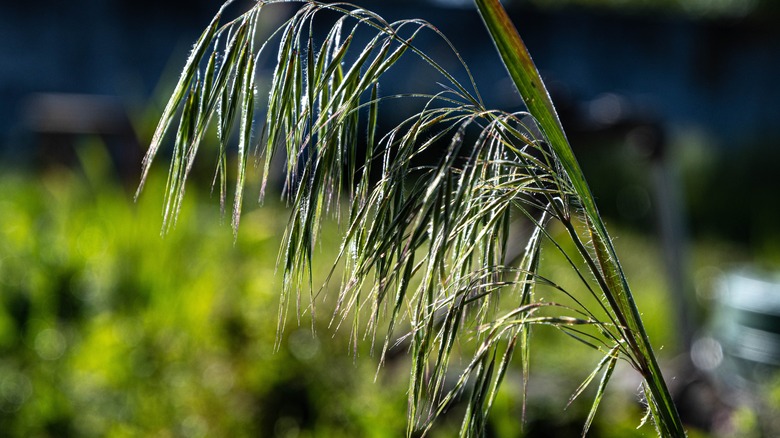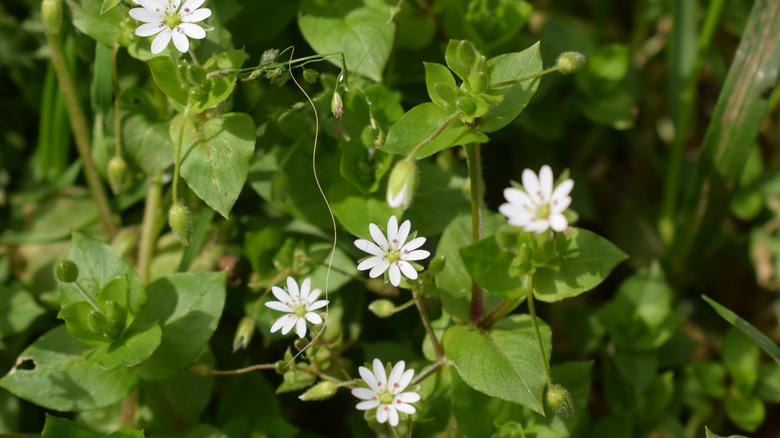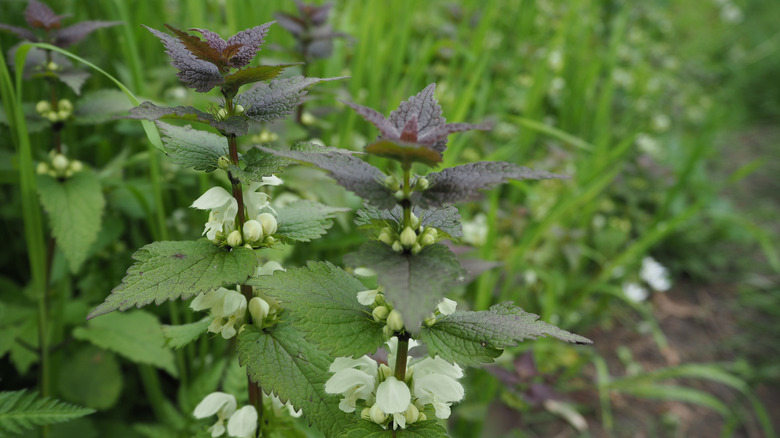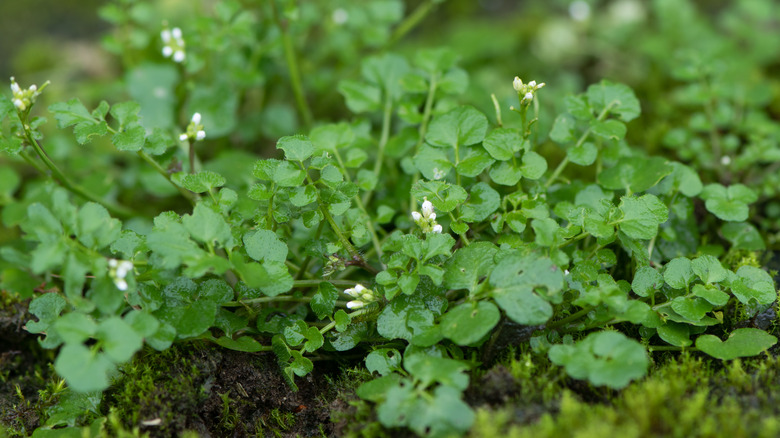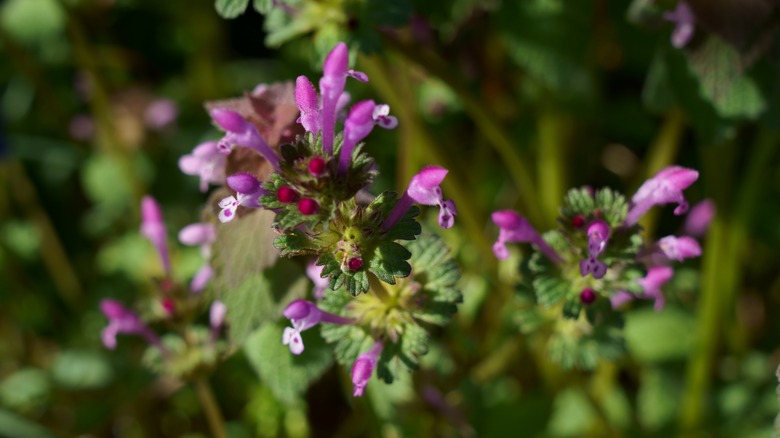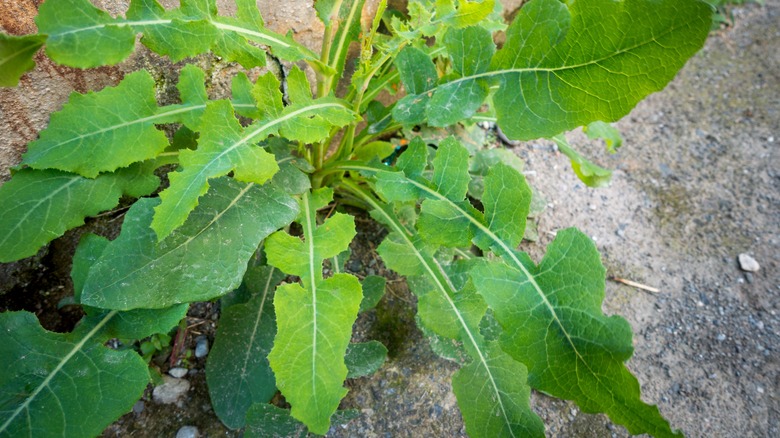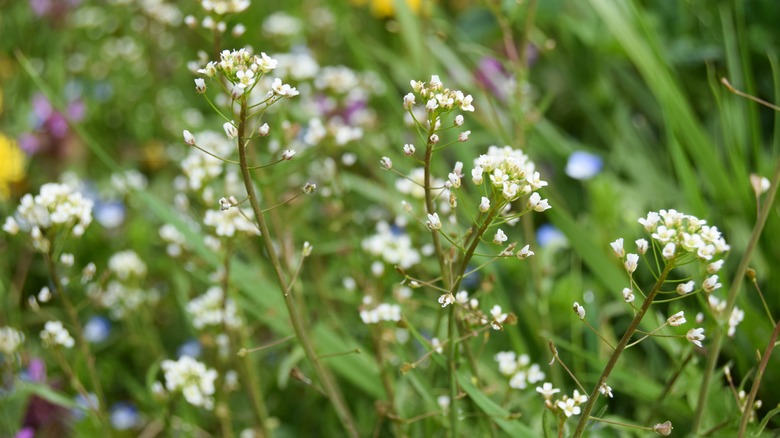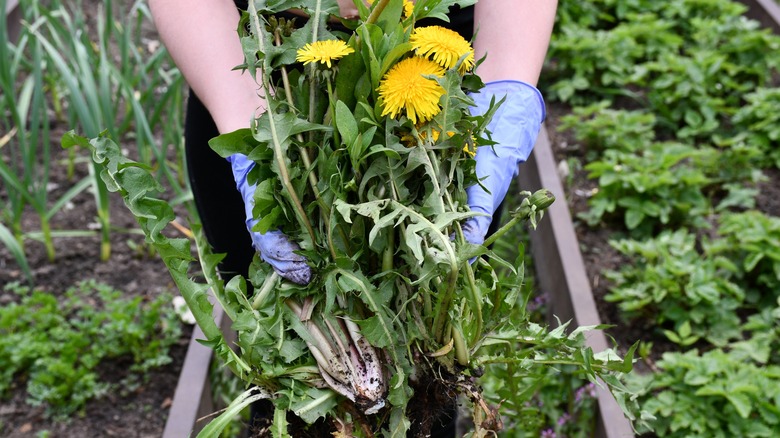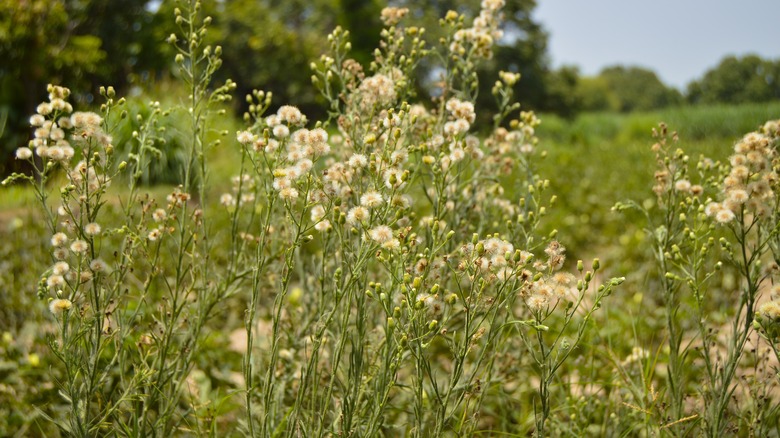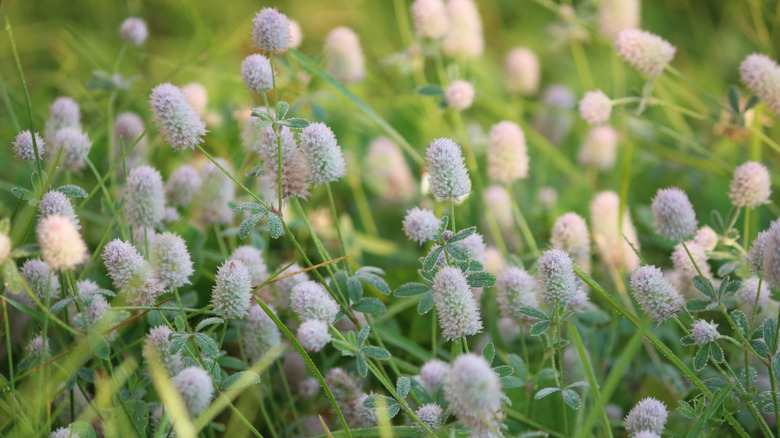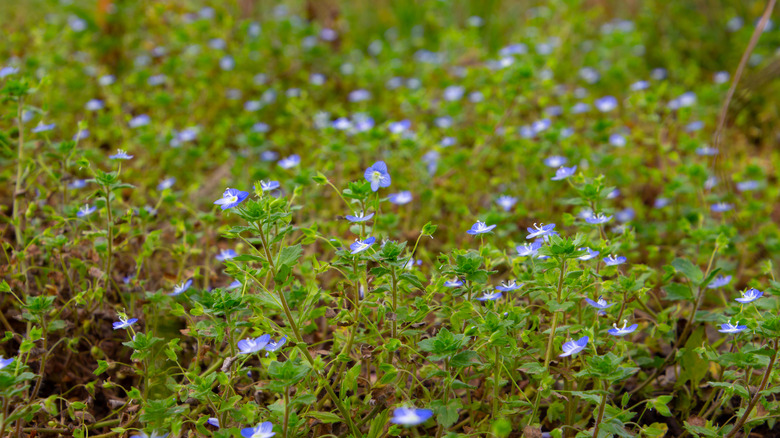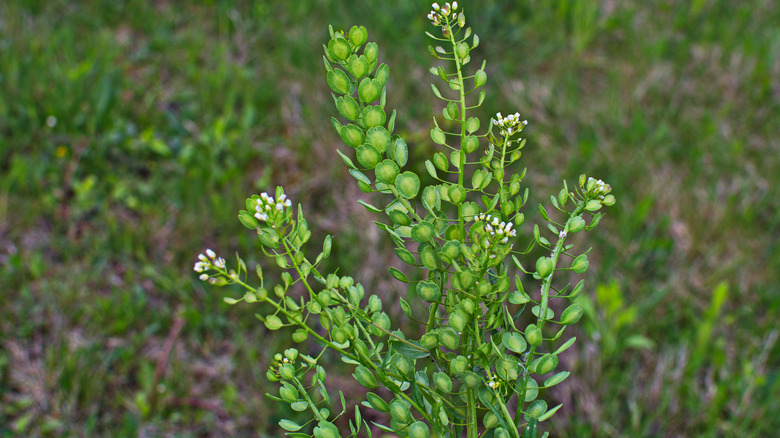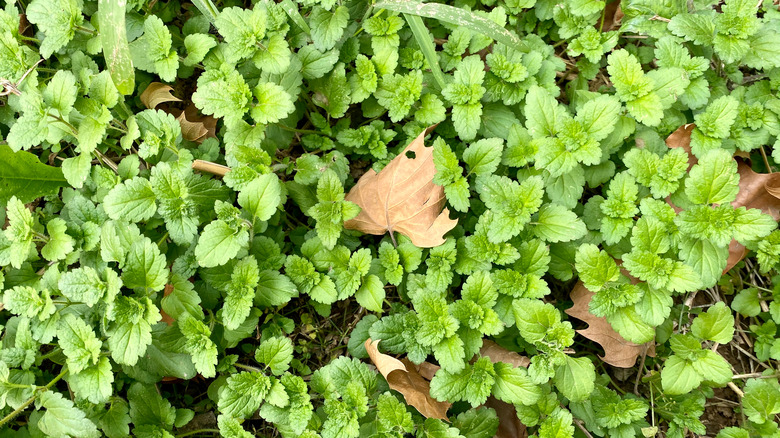Sneaky Weeds That'll Wreak Havoc On Your Lawn During Winter
Winter is often associated with dying plants. So, you may not worry about weeds cropping up and disturbing nearby dormant plants. However, even though the temperatures may be dropping, some species of weeds and plants are just getting started. Many weeds that flower and bloom in the spring begin to grow in the late fall and winter months. Infestations can begin at seeding and severely hinder the growth of planted spring annuals waiting to blossom. Sneaky weeds like annual bluegrass will wreak havoc on your lawn during winter and leave it unrecognizable come spring.
Though some species of weeds benefit the plants around them, most species are invasive, fast-growing, and highly competitive. Even in the cold of winter, weeds can grow and rob nutrients your plants need. Luckily, because most winter annual weeds sprout during this time, they're small and easy to pull or hoe. The sooner you remove the weeds and roots, the healthier your lawn or garden will become.
Annual bluegrass (Poa annua)
Annual bluegrass (Poa annua) is an incredibly common weed known for being a blemish on an otherwise uniform lawn. The best way to tackle annual bluegrass is by catching it early. Once you see a singular or solitary plant, you'll need to remove it immediately. Bluegrass disperses seeds through wind, grass cuttings, and animal waste. There are few effective treatments once this weed gets out of control.
Bloom Season: Fall and winter
USDA Growing Zone: 4 to 8
Growing Conditions: Partial shade to full sun
Soil Type: Moist, neutral to acidic
Size: 6 to 8 inches tall
Bedstraw (Galium aparine)
Catchweed bedstraw (Galium aparine) is an incredibly pesky weed that entangles its hook-like leaves in neighboring plants, and leaves burs on clothing and hair. This weed must be dealt with as soon as it appears because it can be incredibly difficult to remove once established. Catchweed bedstraw has a fragile stem that breaks easily when pulled, so portions underneath the soil remain, and the weed continues to thrive.
Bloom Season: Spring and summer
USDA Growing Zone: 3 to 9
Growing Conditions: Full sun, dappled sun, partial sun
Soil Type: Neutral
Size: Up to 6 feet tall
Cheatgrass (Bromus tectorum)
Known by many names, cheatgrass (Bromus tectorum) is an invasive species. It is highly competitive, and if left to thrive, cheatgrass will outcompete your plants for nutrients, thus killing what you actually want in your yard. Cheatgrass produces many seeds that germinate in the fall and bloom in the winter. Luckily, it will die within six weeks of blooming if the air is dry.
Bloom Season: Winter
USDA Growing Zone: 2 to 11
Growing Conditions: Full sun
Soil Type: Moist, low in nitrogen
Size: 4 to 30 inches tall
Common chickweed (Stellaria media)
Common chickweed (Stellaria media) is a winter annual that you may already have in your yard. Chickweed begins to bloom in the late summer and continues to thrive until it becomes dormant in late winter. Chickweed competes with neighboring plants, especially grains. So if you grow wheat, barley, rye, or other grains, it's important to banish chickweed before it seeds again in the early spring.
Bloom Season: Late summer
USDA Growing Zone: 4 to 11
Growing Conditions: Full sun to partial shade
Soil Type: Moist
Size: Up to 16 inches tall
Purple deadnettle (Lamium purpureum)
Purple deadnettle (Lamium purpureum), also called red deadnettle or simply deadnettle, is an interesting weed known for its medicinal and edible properties. It is also invasive in the U.S. and will disrupt your garden like many other weeds. Moreover, this pesky weed is resistant to many garden pests. So you'll need to tackle it on your own before it wreaks havoc on your yard.
Bloom Season: Year-round
USDA Growing Zone: 3 to 8
Growing Conditions: Full sun to partial shade
Soil Type: Acidic, alkaline, neutral
Size: 6 to 8 inches tall
Hairy bittercress (Cardimine hirusta)
If you have hairy bittercress (Cardimine hirusta) in your yard, it can be a blessing and a curse. It forms thick mats that will spread over your lawn or garden plants. However, it is easily pulled. Hairy bittercress has shallow roots that you can fully remove with minimal effort.
Bloom Season: Early spring
USDA Growing Zone: 4 to 8
Growing Conditions: Full sun to partial sun
Soil Type: Acidic, alkaline, neutral and moist
Size: Up to 1 foot tall
Henbit (Lamium amplexicaule)
Henbit deadnettle (Lamium amplexicaule) is often confused with purple deadnettle, but unlike that species, henbit has stemless leaves. However, it is equally disruptive. Each henbit plant can produce hundreds of seeds, so it should be dealt with immediately. Pulling or hoeing is an easy way to get rid of henbit. It is best done when the plant is still young.
Bloom Season: Spring to summer, winter in warmer regions
USDA Growing Zone: 3 to 9
Growing Conditions: Full sun
Soil Type: Dry or moist soil that's loamy or sandy; acidic, alkaline, neutral
Size: Up to 1 foot tall
Prickly lettuce (Lactuca serriola L.)
Prickly lettuce (Lactuca serriola L.) is a wild lettuce species and invasive weed. Seeds germinate in the fall once temperatures drop. Then, prickly lettuce begins to bloom and compete with neighboring plants. The weed has jagged-looking prickly leaves with sticky fibers on the underside. When it flowers, prickly lettuce has bright yellow blooms. Seeding prevention is the best way to thwart an infestation.
Bloom Season: Late winter to early spring
USDA Growing Zone: 6 to 9
Growing Conditions: Full sun to partial shade
Soil Type: Dry soil; grows in all soil types
Size: Up to 40 inches tall
Shepherd's purse (Capsella bursa-pastoris)
The flowers of shepherd's purse (Capsella bursa-pastoris) look fairly harmless, but this broadleaf weed is a highly competitive species that infests many gardens, lawns, and disturbed areas. Shepherd's purse is considered invasive in several states like Arizona, California, Hawaii, Maryland, Nevada, Utah, and Virginia. Pulling the weeds by hand is best done when plants are young and flowers have yet to bloom.
Bloom Season: Late winter to early spring
USDA Growing Zone: 2 to 9
Growing Conditions: Full sun to partial shade
Soil Type: Acidic, alkaline, neutral
Size: Up to 26 inches tall
Dandelion (Taraxacum officinale)
Dandelions (Taraxacum officinale), as charming as their flowers may look, are an invasive species. Though they are less of a threat than species like henbit, dandelions disperse over 5,000 seeds per plant annually. So, they reproduce very quickly. Hoeing is the only way to ensure you remove the entire plant.
Bloom Season: Late spring to fall
USDA Growing Zone: 3 to 9
Growing Conditions: Full sun
Soil Type: Acidic
Size: 6 to 24 inches tall
Horseweed (Conyza canadensis)
Like dandelions, horseweed (Conyza canadensis) has multiple appearances depending on the stage. It starts with jagged leaves, then grows soft bristles, and finally, tiny white flowers. Though competitive crops can push horseweed out of a summer garden, you will likely have to pull them out of the soil during winter.
Bloom Season: Winter or summer
USDA Growing Zone: 3 to 9
Growing Conditions: Full sun
Soil Type: Slightly acidic to neutral
Size: Up to 7 feet tall
Hare's-foot clover (Trifolium arvense)
Hare's-foot clover (Trifolium arvense), also called rabbit's foot clover, is a fluffy-looking weed that can overtake sandy areas. It also threatens vineyards and orchards. Hare's-foot clover releases seeds that spread through wind gusts and germinate quickly. So, it's important to pull weeds completely whenever you see them.
Bloom Season: Late summer to fall
USDA Growing Zone: 3 to 11
Growing Conditions: Full sun, partial shade
Soil Type: Acidic and alkaline
Size: 4 to 16 inches tall
Corn speedwell (Veronica arvensis)
Corn speedwell (Veronica arvensis) is cute when it grows alone but disruptive in a colony. Luckily, this weak weed is easily defeated with dense planting. If corn speedwell threatens your lawn, the solution may be as simple as over-seeding your sod.
Bloom Season: Spring and summer
USDA Growing Zone: 6 to 9
Growing Conditions: Full sun, partial shade
Soil Type: Acidic, alkaline, neutral
Size: Up to 8 inches tall and 12 inches wide
Field pennycress (Thlaspi arvense)
Field pennycress (Thlaspi arvense) is a fast-growing, edible weed from the mustard family. It starts as small, unassuming, oblong leaves in the fall and grows tall stems with tiny white flowers in the spring. If field pennycress is pulled up before it blooms, it won't overrun your yard once temperatures rise.
Bloom Season: Spring
USDA Growing Zone: 5 to 9
Growing Conditions: Full sun
Soil Type: Alkaline
Size: 1 to 2 feet tall
Persian speedwell (Veronica persica)
As its common name may suggest, Persian speedwell (Veronica persica) grows quickly and spreads rapidly. Persian speedwell will germinate in the fall and then grow small purple or blue flowers in the winter. Hand-pulling is the most effective way to get rid of Persian speedwell. Herbicides are also effective but not ideal in gardens.
Bloom Season: Winter through summer
USDA Growing Zone: 4 to 8
Growing Conditions: Full sun, partial shade
Soil Type: Slightly acidic to neutral
Size: Up to 8 inches tall and 12 inches wide
